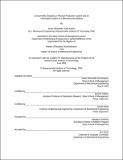Concurrently designing a physical production system and an information system in a manufacturing setting
Author(s)
Katzen, James Alexander Scott, 1974-
DownloadFull printable version (2.221Mb)
Other Contributors
Leaders for Manufacturing Program.
Advisor
Jeremie Gallien and David Hardt.
Terms of use
Metadata
Show full item recordAbstract
The advancement of information technology in manufacturing requires process architects to refine their procedures used to design new manufacturing systems. No longer can these designers implement a physical production system first, and then later incorporate a capable information system to control that production system. Rather, the physical production system and the information system must be designed concurrently to ensure the resulting system yields a seamless flow of information as well as physical material. This thesis reviews the traditional methodology used to design a physical production process. The major tools and steps of that methodology will be reviewed, and case examples will be provided showing how the traditional method is typically applied. Two major shortcomings of the design process (the neglecting of the flow of information and its overly sequential nature) will be identified. To address these shortcomings, specific concepts, models, and methods have been developed. These new tools form the structure of an improved design methodology for manufacturing processes. This thesis provides case examples where the new concepts, models, and methods were applied. These cases provide concrete illustrations of situations where these ideas have been successfully implemented. The overall concepts presented are: 1) the flow of information is as important as the flow of product; 2) the flow of information is often more complicated than the flow of physical material, and frequently it is the sharing of information within a process that governs the process' performance; 3) the flow of information can be modeled as the flow of physical parts, so many of the same principles that apply to the design of physical production systems can be applied to the design of information systems; and 4) the design of an information system must occur in a concurrent fashion with the development of the physical components of any manufacturing process.
Description
Thesis (S.M.)--Massachusetts Institute of Technology, Dept. of Mechanical Engineering; and, (M.B.A.)--Massachusetts Institute of Technology, Sloan School of Management; in conjunction with the Leaders for Manufacturing Program at MIT, 2003. This electronic version was submitted by the student author. The certified thesis is available in the Institute Archives and Special Collections. Includes bibliographical references (p. 173-176).
Date issued
2003Department
Leaders for Manufacturing Program at MIT; Massachusetts Institute of Technology. Department of Mechanical Engineering; Sloan School of ManagementPublisher
Massachusetts Institute of Technology
Keywords
Mechanical Engineering., Sloan School of Management., Leaders for Manufacturing Program.